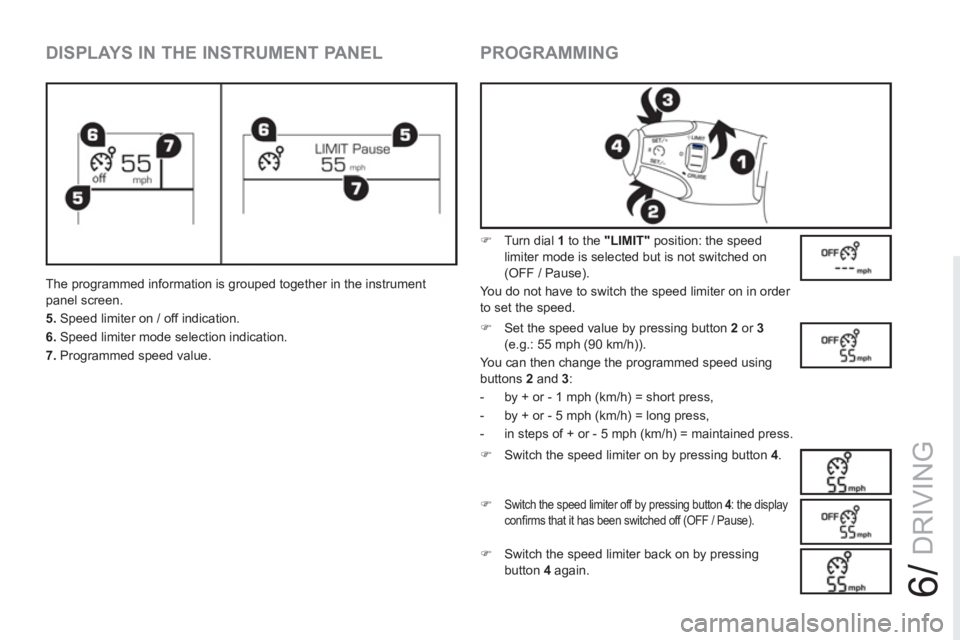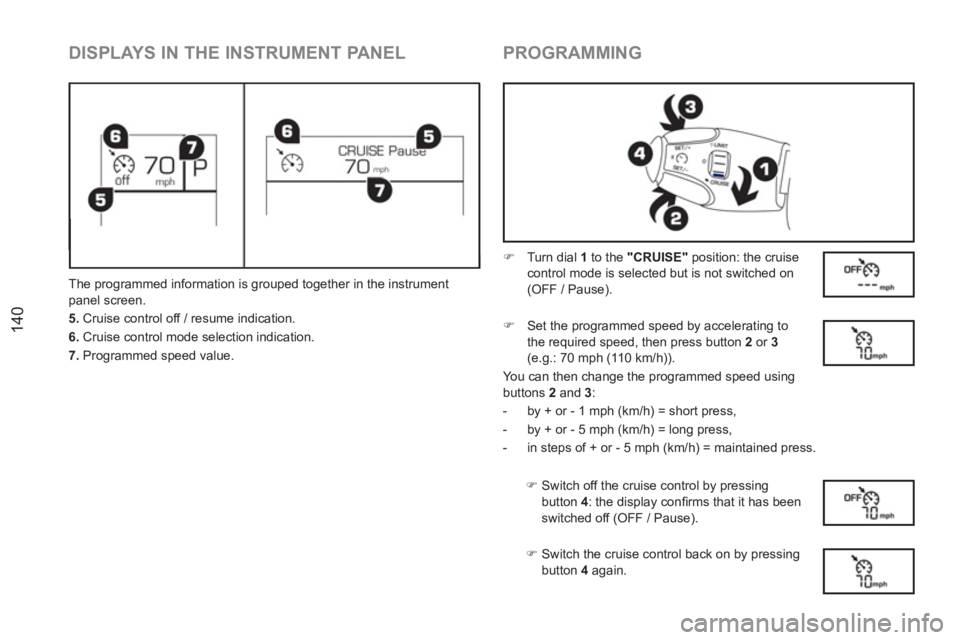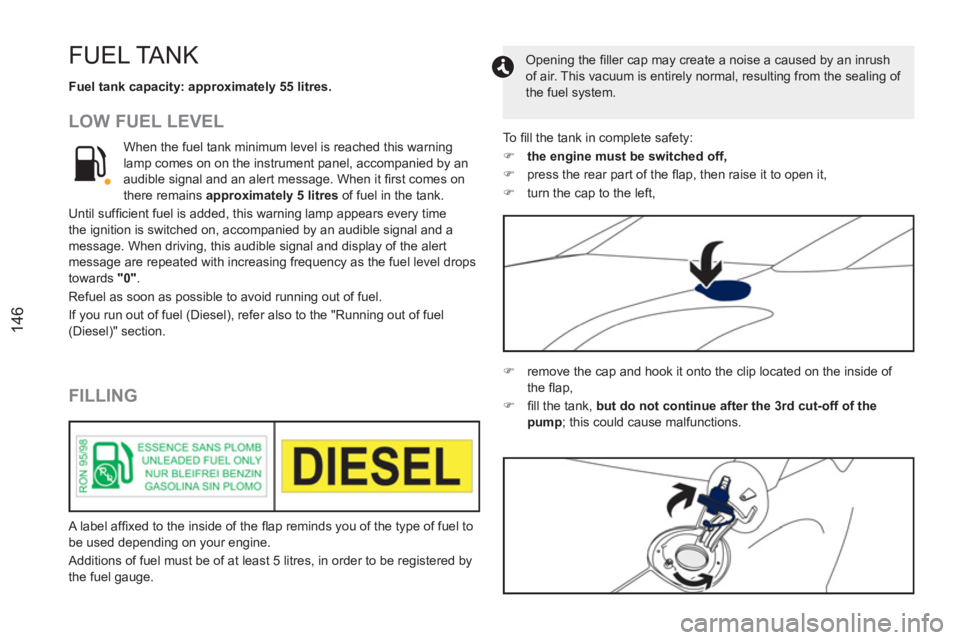2012 PEUGEOT RCZ instrument panel
[x] Cancel search: instrument panelPage 137 of 336

6/
DRIVING
It is only possible to change from one gear to another if the vehicle
speed and engine speed permit; otherwise, the gearbox will operate
temporarily in automatic mode.
M
and the gears engaged manually appear in succession in
the instrument panel.
If the engine speed is too low or too high, the gear selected
fl ashes for a few seconds, then the actual gear engaged is
displayed.
It is possible to change from position D
(automatic) to position M
(manual) at any time.
When the vehicle is stationary or moving very slowly, the gearbox
selects gear M1
automatically.
The sport and snow programmes do not operate in manual mode.
Invalid value during manual operation
This symbol is displayed if a gear is not engaged correctly
(selector between two positions).
STOPPING THE VEHICLE
Before switching off the engine, you can engage position P
or N
to
place the gearbox in neutral.
In both cases, apply the parking brake to immobilise the vehicle. If the lever is not in position P
, when the driver's door is opened or
approximately 45 seconds after the ignition is switched off, there is
an audible signal is heard accompanied by a message.
�)
Return the lever to position P
; the audible signal stops and the
message disappears.
OPERATING FAULT
When the ignition is on, the illumination of this warning lamp,
accompanied by an audible signal and a message in the
screen, indicates a gearbox malfunction.
In this case, the gearbox switches to emergency mode and is locked in
3rd gear. You may feel a substantial knock when changing from P
to R
and from N
to R
. This will not cause any damage to the gearbox.
Do not exceed a speed of 60 mph (100 km/h), local speed restrictions
permitting.
Have it checked by a PEUGEOT dealer or a qualifi ed workshop.
This warning lamp may also come on if a door is opened.
There is a risk of damage to the gearbox:
- if you press the accelerator and brake pedals at the same
time,
- if you force the lever from position P
to another position when
the battery is fl at.
To reduce fuel consumption during a long period stationary with
the engine running (traffi c jam, etc.), place the gear lever in
position N
and apply the parking brake.
Page 139 of 336

6/
DRIVING
DISPLAYS IN THE INSTRUMENT PANEL
The programmed information is grouped together in the instrument
panel screen.
5.
Speed limiter on / off indication.
6.
Speed limiter mode selection indication.
7.
Programmed speed value.
PROGRAMMING
�)
Turn dial 1
to the "LIMIT"
position: the speed
limiter mode is selected but is not switched on
(OFF / Pause).
You do not have to switch the speed limiter on in order
to set the speed.
�)
Set the speed value by pressing button 2
or 3
(e.g.: 55 mph (90 km/h)).
You can then change the programmed speed using
buttons 2
and 3
:
- by + or - 1 mph (km/h) = short press,
- by + or - 5 mph (km/h) = long press,
- in steps of + or - 5 mph (km/h) = maintained press.
�)
Switch the speed limiter on by pressing button 4
.
�)
Switch the speed limiter off by pressing button 4
: the display
confi rms that it has been switched off (OFF / Pause).
�)
Switch the speed limiter back on by pressing
button 4
again.
Page 142 of 336

140
DISPLAYS IN THE INSTRUMENT PANEL
The programmed information is grouped together in the instrument
panel screen.
5.
Cruise control off / resume indication.
6.
Cruise control mode selection indication.
7.
Programmed speed value.
PROGRAMMING
�)
Turn dial 1
to the "CRUISE"
position: the cruise
control mode is selected but is not switched on
(OFF / Pause).
�)
Set the programmed speed by accelerating to
the required speed, then press button 2
or 3
(e.g.: 70 mph (110 km/h)).
You can then change the programmed speed using
buttons 2
and 3
:
- by + or - 1 mph (km/h) = short press,
- by + or - 5 mph (km/h) = long press,
- in steps of + or - 5 mph (km/h) = maintained press.
�)
Switch off the cruise control by pressing
button 4
: the display confi rms that it has been
switched off (OFF / Pause).
�)
Switch the cruise control back on by pressing
button 4
again.
Page 146 of 336

144
Deactivation / Activation of the rear parking sensors
The function is deactivated or activated via the vehicle
confi guration menu.
The status of the function is stored when the ignition is switched off.
For more information on access to the parking sensors menu,
refer to the section covering the confi guration of vehicle systems.
OPERATING FAULT
In the event of a malfunction of the system, when reverse gear
is engaged this warning lamp is displayed in the instrument
panel and/or a message appears in the screen, accompanied
by an audible signal (short beep).
Contact a PEUGEOT dealer or a qualifi ed workshop.
In bad weather or in winter, ensure that the sensors are not
covered with mud, ice or snow. When reverse gear is engaged, an
audible signal (long beep) indicates that the sensors may be dirty.
Certain sound sources (motorcycle, lorry, pneumatic drill, etc.)
may trigger the audible signals of the parking sensor system.
The function will be deactivated automatically if a trailer is being
towed or a bicycle carrier is fi tted (vehicle fi tted with a towbar or
bicycle carrier recommended by PEUGEOT).
Page 148 of 336

146
FUEL TANK
Fuel tank capacity: approximately 55 litres.
LOW FUEL LEVEL
FILLING
When the fuel tank minimum level is reached this warning
lamp comes on on the instrument panel, accompanied by an
audible signal and an alert message. When it fi rst comes on
there remains approximately 5 litres
of fuel in the tank.
Until suffi cient fuel is added, this warning lamp appears every time
the ignition is switched on, accompanied by an audible signal and a
message. When driving, this audible signal and display of the alert
message are repeated with increasing frequency as the fuel level drops
towards "0"
.
Refuel as soon as possible to avoid running out of fuel.
If you run out of fuel (Diesel), refer also to the "Running out of fuel
(Diesel)" section.
A label affi xed to the inside of the fl ap reminds you of the type of fuel to
be used depending on your engine.
Additions of fuel must be of at least 5 litres, in order to be registered by
the fuel gauge. To fi ll the tank in complete safety:
�)
the engine must be switched off,
�)
press the rear part of the fl ap, then raise it to open it,
�)
turn the cap to the left,
�)
remove the cap and hook it onto the clip located on the inside of
the fl ap,
�)
fi ll the tank, but do not continue after the 3rd cut-off of the
pump
; this could cause malfunctions. Opening the fi ller cap may create a noise a caused by an inrush
of air. This vacuum is entirely normal, resulting from the sealing of
the fuel system.
Page 154 of 336

152
CHECKING LEVELS
OIL LEVEL
The check is carried out either when the ignition is switched
on using the oil level indicator in the instrument panel, or using
the dipstick.
It will only be correct if the vehicle is on level ground and the engine
has been off for more than 30 minutes.
Take care when working under the bonnet, as certain areas of the engine may be extremely hot (risk of burns) and the cooling fan could start
at any time (even with the ignition off).
If a level drops signifi cantly, have the corresponding system checked by a PEUGEOT dealer or a qualifi ed workshop.
Check all of these levels regularly, in line with the servicing booklet and the requirements of the warranties. Top them up if necessary, unless otherwise indicated.
Engine oil change
Refer to the servicing and warranty booklet for details of the interval
for this operation.
In order to maintain the reliability of the engine and emission control
system, the use of additives in the engine oil is prohibited. It is normal to top up the oil level between two services (or oil
changes). PEUGEOT recommends that you check the level, and
top up if necessary, every 3 000 miles (5 000 kms).
After topping up the oil, the check when switching on the ignition with
the oil level indicator in the instrument panel is not valid during the
30 minutes after topping up.
Oil specification
The oil must be the correct grade for your engine and conform to the
manufacturer's recommendations.
BRAKE FLUID LEVEL
The brake fl uid level should be close to the "MAX" mark.
If it is not, check the brake pad wear.
Changing the fluid
Refer to the servicing and warranty booklet for details of the interval
for this operation.
Fluid specification
The brake fl uid must conform to the manufacturer's recommendations
and meet the DOT3 or DOT4 standard.
POWER STEERING FLUID LEVEL
The power steering fl uid level should be close to the "MAX"
mark. With the engine cold, unscrew the cap to check the level.
Page 155 of 336

7/
F0
CHECKS
ADDITIVE LEVEL (DIESEL WITH PARTICLE
EMISSIONS FILTER)
The additive reservoir low level is indicated by fi xed
illumination of this warning lamp, accompanied by an audible
signal and a message that the particle emissions fi lter additive
level is too low.
Topping up
The reservoir must be topped up without delay by a PEUGEOT dealer
or a qualifi ed workshop.
USED PRODUCTS
Avoid prolonged contact of used oil or fl uids with the skin.
Most of these fl uids are harmful to health or indeed very corrosive.
Do not discard used oil or fl uids into sewers or onto the ground.
Take used oil to a PEUGEOT dealer or a qualifi ed workshop
(France) or to an authorised waste disposal site.
COOLANT LEVEL
The coolant level should be close to the "MAX" mark but
should never exceed it.
When the engine is warm, the temperature of the coolant is regulated
by the fan.
In addition, as the cooling system is pressurised, wait at least one hour
after switching off the engine before carrying out any work.
To avoid any risk of scalding, unscrew the cap by two turns to allow the
pressure to drop. When the pressure has dropped, remove the cap and
top up the level.
The cooling fan may start after switching off the engine: take
care with articles and clothing that might become caught by the
fan blades.
Changing the coolant
The coolant does not have to be changed.
Fluid specification
The coolant must conform to the manufacturer's recommendations.
SCREENWASH AND HEADLAMP
WASH FLUID
In the case of vehicles fi tted with headlamp washers, the low
fl uid level is indicated by an audible signal and a message in
the instrument panel screen.
Top up the reservoir when you next stop the vehicle.
Fluid specification
For optimum cleaning and to avoid freezing, this fl uid must not be
topped up with or replaced with plain water.
Page 184 of 336

182
DASHBOARD FUSES
The fusebox is placed in the lower part of the dashboard (left hand side,
inside the glove box). It consists of two boxes.
Access to the fuses
�)
refer to the paragraph "Access to tools".
Fuse tables
Fuse N°
Rating
Functions
F1
-
Not used.
F2
30 A
Locking and deadlocking earth.
F3
5 A
Airbags, active bonnet and pretensioners
control unit.
F4
10 A
Clutch pedal switch, electrochrome
rear view mirror, automatic gearbox,
switching and protection unit.
F5
30 A
One-touch electric windows, folding
mirrors supply.
F6
-
Not used.
F7
5 A
Front and rear courtesy lamps, map
reading lamps, sun visor lighting, glove
box lighting.
F8
20 A
Audio equipment, audio/telephone,
multifunction screen, tyre under-infl ation
detection, clock.
F9
30 A
12 V socket.
F10
15 A
Steering mounted controls.
F11
15 A
Low current ignition switch.
F12
15 A
Instrument panel, air conditioning,
driver's seat memory unit, rain /
sunshine sensor, airbags.
Box 1